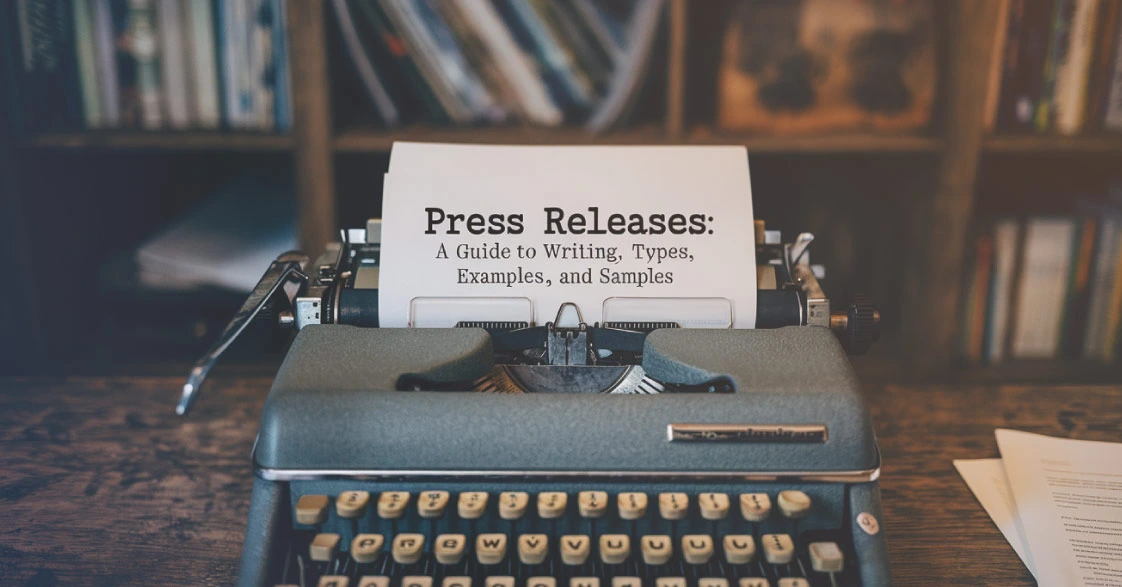Press Releases: A Guide to Writing, Types, Examples, and Samples

In the world of public relations, press releases remain a powerful tool for sharing news, enhancing visibility, and establishing credibility. Press releases connect organizations with their audiences, from product launches to crisis communication. This guide unpacks the essential elements of press releases, breaking down structure, content, formatting, distribution, and optimization techniques to ensure your press release achieves its goals.
Press Release Structure
A well-structured press release makes the content easy to read and effectively conveys the intended message. Below is a breakdown of its key components with actionable insights:
Headline: Attention-Grabbing Title
Essence: The headline is the hook; it must captivate and entice the reader to continue.
Tips:
- Keep it concise (ideally under 80 characters).
- Use strong action verbs to convey dynamism.
- Include relevant keywords to improve search engine optimization (SEO).
Examples:
"LG Launches Revolutionary Solar-Powered Smartphone"
“EcoBank Achieves Carbon Neutrality Across All Branches”
Subheading: Adding Context
Purpose: A subheading expands on the headline and provides additional details, offering clarity or highlighting the news's unique aspect.
Tips:
- Use the subheading to convey the key takeaway.
- Incorporate secondary keywords to enhance SEO and reach.
Example:
"Oppo" new device aims to redefine sustainability in the tech industry with innovative solar solutions."
Opening Paragraph: The 5 W's
Essence: The opening paragraph serves as the summary, answering the essential questions: Who? What? When? Where? Why?
Tips:
- Keep it concise and engaging, summarizing the key information in 1-2 sentences.
Example:
“Tech Company announced today the launch of the world's first solar-powered smartphone, unveiled at the Global Tech Expo in Berlin, aiming to reduce carbon emissions in tech manufacturing.”
- Body Paragraphs: Expanding the Story
- Structure: The body paragraphs provide further details, offering context and supporting evidence.
Key Elements:
- Expand on the announcement: Provide more information about the product, event, or achievement.
- Include quotes: Statements from stakeholders, such as company executives, add credibility and a human touch.
- Use data and examples: Support claims with relevant facts, statistics, or use cases.
Example:
“According to Public Media Solution CEO Ravinder Bharti, 'This innovation represents a significant leap in sustainable technology. We're excited to lead this change.' The smartphone is projected to reduce energy consumption by 30% compared to traditional devices.”
Closing Paragraph: Call-to-Action
Purpose: The final paragraph should clearly indicate the reader's next step. It often includes links to additional information, registration pages, or contact details.
Tips:
- Make the call-to-action (CTA) specific and actionable.
- Provide contact information for media inquiries.
Example:
“For more details, visit Public Media Solution's website at www.publicmediasolution.com or contact our media team at connect@publicmediasolution.com.”
Why This Structure Works
- Clarity: Each section serves a distinct purpose, ensuring that readers quickly understand the message.
- Engagement: Strategic use of headlines, quotes, and multimedia elements keeps readers interested.
- SEO-Friendly: Keyword-rich content increases visibility and reach online.
This structured approach ensures a professional, impactful press release that resonates with both media professionals and the general audience.
- The content of a press release is critical to its success. It must be newsworthy, relevant, and compelling to capture media interest and engage your target audience. Below, we explore the essential elements of effective press release content:
- Newsworthy Events
Why It Matters:
Newsworthiness is what makes your press release valuable to journalists and readers. It should provide timely, impactful, or unique information.Examples of Newsworthy Topics:
Product Launch:Highlighting innovations or features that stand out.
Example:
“GreenTech announces its revolutionary solar panels that offer 25% higher efficiency, setting a new industry standard for sustainable energy solutions.”Company Milestones: Celebrating significant achievements that reinforce brand credibility.
Example: “Fashionista celebrates 50 years with exclusive collections and runway shows that honour its legacy of redefining style.”
Pro Tip: Ensure that your news aligns with what the target audience or media outlet finds valuable.
- Key Messages
Focus: Clearly articulate the unique aspects of your announcement that set it apart. This is your key selling point and should resonate with both the media and your target audience.
Example of a Key Message:
“Samsung's solar phone is the first to achieve 48-hour battery life under standard sunlight, a milestone in eco-friendly technology.”
Best Practices:
Keep your messages concise and focused on benefits.
Align your messaging with your brand values and target audience needs.
- Supporting Details
Why It Matters: The supporting details build credibility and add depth to your announcement. They provide the context and evidence needed to substantiate your claims.
Key Elements:
Data and Statistics: Include concrete facts to back your story.
Example: “Apple's new phone has reduced CO2 emissions by 20 metric tons in its initial production phase, setting a benchmark for green technology manufacturing.”
Quotes: Incorporate quotes from executives, partners, or customers to add a human touch and authority.
Example:" 'This innovation reflects our commitment to sustainability and technological advancement,' said Ravinder Bharti, CEO of Public Media Solution."
Multimedia: Enhance your press release with visual elements to engage readers and increase shareability.
Examples:
Infographics: Simplify complex data or processes.
High-Resolution Images: Showcase your product or event.
Videos: Provide dynamic storytelling to complement the written content.
Why Content Matters
Engagement: Well-crafted content keeps readers interested and motivates them to take action.
Credibility: Supporting details, such as data and quotes, validate your claims.
Shareability: Multimedia elements and concise messaging increase the likelihood of media coverage and social media shares.
By ensuring your press release content is newsworthy, focused on key messages, and supported by compelling details, you'll create a powerful tool for generating media coverage and building brand awareness.
- Press Release Formatting
Proper formatting makes your press release professional, clear, and attractive to media outlets.Here's how to format your press release for the best results:
Length
- Ideal Range: Aim for 400–600 words.
- This keeps the press release concise while providing enough detail to convey the story effectively.
- Avoid Fluff: Focus on essential details and remove redundant or
irrelevant information.
- Example: Instead of saying, "Our company is thrilled to announce a brand-new product that we've been working on for quite some time," write: “XYZ Corp proudly unveils its latest innovation: a high-efficiency solar panel that sets a new industry benchmark.”
Layout
- Font and Spacing:
- Use a legible font (e.g., Arial or Times New Roman) in 11–12 pt size.
- Maintain single spacing with clear breaks between sections.
- Headings and Subheadings:
- Structure the content into digestible sections, each marked by an informative heading.
- Example:
- Headline: "EcoBank Achieves Carbon Neutrality Across All Branches"
- Subheading: “A Major Milestone in Sustainable Banking Practices”
- Bullet Points and Lists:
- Use bullet points or numbered lists to emphasize key facts or benefits.
- Example:
- "Key Benefits of XYZ New Solar Phone:"
- 48-hour battery life under sunlight.
- Reduces CO2 emissions by 20 metric tons.
- "Key Benefits of XYZ New Solar Phone:"
Tone
- Professional Yet Engaging:
- Write in a tone that balances authority and approachability.
- Use action-oriented language for clarity and energy.
- Example:
- Professional: "This initiative aligns with our commitment to corporate sustainability."
- Engaging: “'We're setting the bar for eco-friendly practices in tech,' said Jane Doe, CEO of Sunpharma.”
- Adapt Tone to the Audience:
- When addressing media professionals, maintain a formal tone.
- For broader audiences or social media, include conversational elements.
Press Release Distribution
An impactful press release is only effective if it reaches the right audience.
Press Release Platforms
- For wide distribution, use services like Press Release Distribution Services, EINpresswire, PR Newswire, Business Wire, and Cision.
- Target industry-specific sites for niche audiences.
Media Outreach
- Build relationships with journalists and editors.
- Personalize pitches for better engagement.
Social Media
- Share snippets of your press release on platforms like Twitter or LinkedIn with relevant hashtags.
Tracking and Analytics
Measuring the success of a press release is crucial to refining future strategies.
Monitoring News Coverage
- Use tools like Google Alerts, Tag Manager or Cision to track media mentions.
Measuring Success
- Key metrics:
- Website Traffic: Monitor spikes after release distribution.
- Social Media Engagement: Track likes, shares, and comments.
Best Practices
Timeliness
- Release press releases at optimal times, such as early weekdays.
Authenticity
- Be transparent and avoid exaggeration.
SEO Optimization
- Incorporate keywords naturally to improve search rankings.
- Ensure mobile-friendliness.
- Emerging Trends in Press Releases
- Multimedia Integration: Videos, GIFs, and infographics are now essential.
- AI and Automation: Tools like ChatGPT or human are being used to draft releases.
- Personalization: Customized press releases targeted to specific demographics.

FAQs About Press Releases
- A strong headline to grab attention.
- A clear structure, including the 5 W's (Who, What, When, Where, Why).
- Engaging content that provides value and avoids jargon.
- Media coverage: How many outlets picked up the story?
- Website traffic: Visits generated from the release.
- Engagement metrics: Shares, comments, or interactions on social media.
- Press release platforms like PR Newswire.
- Media outreach via personalized emails to journalists.
- Social media sharing to amplify reach among your audience.
- Automating writing for faster turnaround.
- Optimizing content with keyword suggestions.
- Providing distribution insights to target the right audience and track results effectively.
Share
Table Of Contents
- Press Release Structure
- Why This Structure Works?
- Why It Matters
- Why Content Matters
- Press Release Platforms
